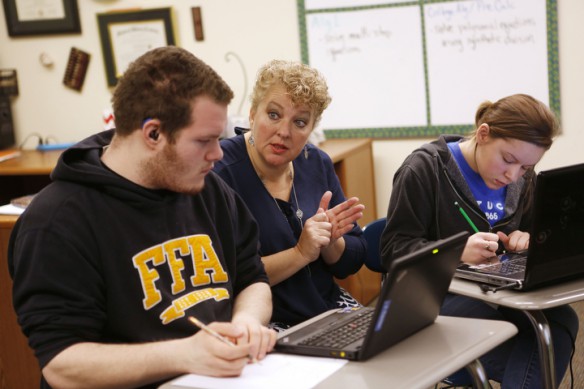
Lee Alan Roher works with juniors Jeffery Carter and Brianna Jones on adding and subtracting complex numbers at the Kentucky School for the Deaf.
Photo by Amy Wallot, Jan. 15, 2015
By Mike Marsee
michael.marsee@education.ky.gov
When students in a math class aren’t learning at the same pace, Lee Alan Roher has a way of bringing them all together.
Roher’s use of a web-based program in her high school mathematics classes at Kentucky School for the Deaf allows her to meet students at any point in their progress and to make sure they’re meeting state standards.
And while she didn’t create the program, she has had a role in its evolution and has surely become one of its biggest boosters.
“I use it whenever I possibly can,” Roher said. “Of course, I have time invested in it, using it for this long.”
Roher has sweat equity invested in it as well. She has been working with faculty members in the University of Kentucky’s Department of Mathematics since 2005 on MathClass, which offers interactive homework and diagnostic testing.
The program allows teachers to link questions to individual items within the Kentucky Core Academic Standards for Math (KCAS) thanks in part to a request from Roher, who had already asked the developers for other refinements that she thought would help her and her students.
“All of my assessments, each question is tied to a standard. And then I can either re-teach that standard or remediate for specific students,” she said.
MathClass is a free resource for educators, and it is also used for the Kentucky Early Mathematics Placement Test (KEMPT). Roher has used it in classrooms at both the high school and collegiate level, and she introduced it to her students at KSD upon joining the faculty there at the start of this school year, much to the appreciation of principal Will Begley.
“Her program enables the upper-level students to push forward without holding them back, and she’s also able to remediate and offer intervention to the students that are struggling. Students are able to work at an individual pace and rigor,” said Begley, who has worked with Roher at two schools. “She has an unlimited problem bank and problems are already tied to the standards. And when the students complete their math problems, she is able to identify the standards she may have to re-teach or the standards that she can let the students go deeper with.
“We are looking into how we can utilize her expertise and the program, using technology to reach other deaf and hard-of-hearing students throughout the state that reside in their home districts. Think about the potential this has.”
Begley, who was the principal at Boyle County High School when Roher taught there, said Roher’s work with the program makes her an asset as well.
“When you can help design something, you have a little more buy-in as an educator,” he said.
Roher said she first met MathClass developers Paul Eakin, Carl Eberhart, and Ken Kubota and learned about their work at a UK workshop in 1998, and she went back to them in 2005 when she was looking for an online homework system.
“I talked to Paul, and I said, ‘This is what I want to do. Now, can you help me make this?” And he said, ‘Why would you remake it? Just use what we already have?’” Roher said. “At that time it was only multiple choice, and we went to open response so that you can actually type in numerical answers, you can type in words, you can type in mathematical expressions. And then they moved on to where you can have an actual extended response where you type it out in paragraph form, and then it also has the math font. So if you type the math in, it becomes the math font.”
“And then I said, ‘I really want to do use the site, and I want to give my students access to the math outside the classroom,’ and so I use that site. After using the web homework system, I went back to UK and said, ‘You know, I really need to tie each question to a standard,’ and so they said, ‘OK, we can do that.’ So they wrote the code for that to be done. There’s been many standards since 2005, and I can just recode the standards as they go and edit the assignments I have to match the standards. I can change the questions, too.”
Roher said one valuable feature of MathClass, which is also used for the KEMTP and in dual credit classes taught through Kentucky State University, is its ability to create a unique test for each student in a class.
“Everybody has the same question, but the numbers are changed and the order of the questions is changed,” she said. “And there’s a common version where if you’re studying for a test, you could sit down side by side and have the same exact problems in the same order, and then if you just want various practices you can have the option to select specific versions.”
Roher said the ability for students to see immediate results of their work is helpful because students see that they are making a mistake. If they cannot find their own mistake, she can help them find their error.
“The student will not continue to practice using an incorrect method. Many students with paper work or book work never check their answers, and they ingrain an incorrect process,” she said.
She said students benefit from immediate feedback on tests as well.
“The test isn’t over for the students when they submit their answers. Once they submit and see what they have right and wrong, students are still thinking about it. It’s not just turn in the paper and it’s over and they walk out the door. They’re thinking about, ‘Why did I get this one wrong?’ and they find errors. It’s immediate feedback,” Roher said.
MORE INFO…
Lee Alan Roher leealan.roher@ksd.kyschools.us
Will Begley will.begley@ksd.kyschools.us
MathClass www.mathclass.org




Leave A Comment